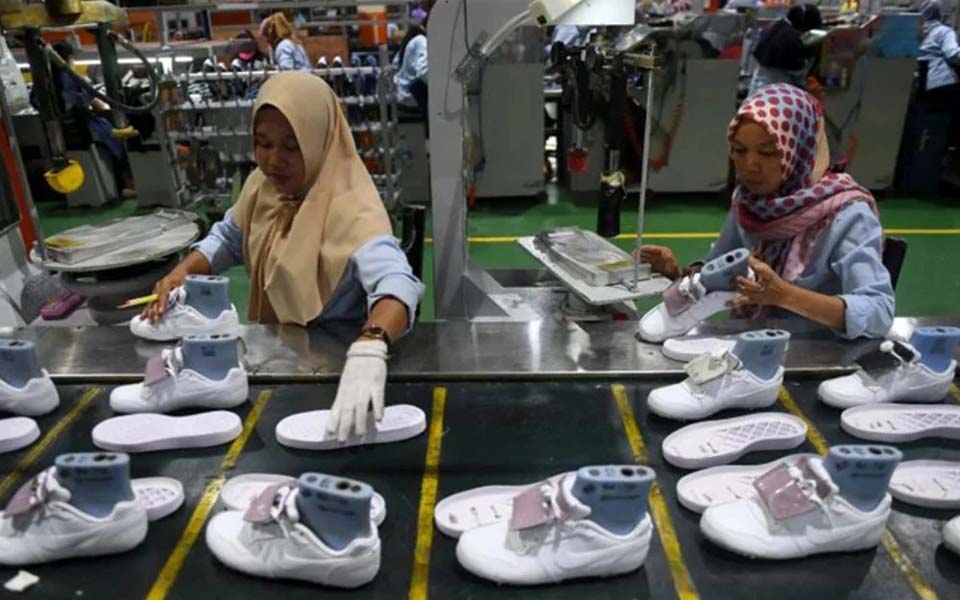AC Nielsen research shows that the recent decline in consumption is not a result of a shift to online shopping because the digital trade segment accounts for only 1 percent of consumption.
Asep Wijaya – It’s not just traders and retail shops that have been hit of late. Producers of fast moving consumer goods (FMCG) have also suffered slow sales growth over the first nine months of the year.
This further reinforces other indications of weakening purchasing power, particularly among the lower middle-class, compared with the influence of a trend towards electronic sales (e-commerce).
Based on data from the Nielson survey institute, sales of consumer goods over the period January-September 2017 have only grown by 2.7 percent. This figure continues a slowing trend in the sale of FMCG that grew by 7.7 percent last year, which is below the average annual growth of 11 percent over the last 10 years.
One of the most striking indicators of this was during the Idul Fitri holiday season following the Ramadan fasting month which is normally a harvest season for the sale of consumer goods. This year however, sales growth was only 5 percent or far below growth the levels for the period 2014-2016 which stood at 20.6 percent, 16.3 percent and 13.4 percent respectively.
The sluggish sale of consumer goods is also spread evenly across all regions. In Jakarta FMCG sales declined by 2.3 percent. Likewise in East Java it fell by 0.1 percent. Sales of consumer goods in West and Central Java meanwhile rose only slightly by 6.1 percent and 1.7 percent respectively. Yet these four provinces on Java Island control 68 percent of the consumer goods market in Indonesia.
Only three regions showed a significant growth in consumer goods sales which occurred in concert with business activities specific to these regions.
First, in South Sumatra where sales grew by 8 percent because the region is a palm oil (CPO) producer. Second, in Kalimantan, which grew by 14.3 percent because it is a coal producing region. Third, in Bali and Nusa Tenggara where sales grew by 7.4 percent because of the tourism sector.
AC Nielsen concluded that slow consumer goods sales were not influenced by the online shopping trend. The reason for this is that online FMCG sales last year only amounted to 1.5 trillion rupiah or just 0.3 percent of the total value of consumer goods sales.
This figure is insignificant in comparison with the drop in FMCG sales of 37 trillion rupiah, based on the difference between a FMCG average annual sales growth of 11 percent or 49 trillion rupiah while sales for the period January-September 2017 only grew 2.7 percent or 12 trillion rupiah.
Lower middle-class purchasing power under pressure
Nielsen explained that the reason for the decline in household consumption was because of weakening purchasing power among the lower middle-class. This weakening of purchasing power was caused by a decline in take hope pay and conversely a rise in the cost of living.
Incomes declined because there has been no increase or no significant increase in wages as well as a decline in income from overtime, along with an absense of commissions and other sources of income. The cost of living and household expenditure meanwhile has risen due to increases in electricity rates, food prices and school fees.
People have responded by putting a break on spending with consumption of instant noodles declining by 2.7 percent and instant coffee by 1.5 percent. Conversely, people are electing to buy unprocessed food and making their own snacks as can be seen by an increase in the sale of flour (28.1 percent), cooking oil (13.4 percent) and milk (13.8 percent). They are also choosing products in smaller packaging (sachets) in order to better control consumption.
Economist Faisal Basri in an article title Structural Transformation and Purchasing Power [https://faisalbasri.com/2017/09/26/transformasi-struktural-dan-daya-beli/] also says that there has been a decline in purchasing power among the poorest 40 percent group. The farmer’s exchange rate (NTP) between November 2014 and August 2017 declined from 102.87 to 101.60. The NTP for farmers in food production in particular has declined sharply from 102.0 to 98.3. Basri emphasises that an NTP under 100 is a cause for concern.
Meanwhile the real wage for agricultural workers has also fallen by 2.49 percent between November 2014 and August 2017. During the same period, the real wage for construction workers in urban areas has also experienced a decline of as much as 2.12 percent.
In addition to this, Basri says that there are indications that the decline in purchasing power is spreading to the 40 percent middle-income group, particularly among the medium- and lower-middle class. Among other things this is a result of the removal of electricity subsidies for 900 VA subscribers totalling around 19 million households.
“As a consequence of the removal of these subsidies, average spending on electricity for this group has risen sharply from 80,000 rupiah a month to 170,000 rupiah a month”, said Basri.
The government is also aware of the weakening purchasing power of the lower middle-class and in 2018 will be channeling funds to the Village Fund Program amounting to some 60 trillion rupiah which will be disbursed to around 74 thousand villages. This figure represents a continuing increase from 47 trillion rupiah in 2016 and 21 trillion in 2015.
Unlike the previous years, President Joko “Jokowi” Widodo plans to link the disbursement of the 2018 village funds with an obligation to absorb local labour.
Upper middle-class consumption trends
Unlike the lower middle-class group, AC Nielson’s research shows that consumption is still growing among the top 34 percent income group. The upper-class is still spending its income on maintaining its lifestyle and on things such as eating out, although we should still wait and see.
This explanation for consumption trends among the upper middle-class is in line with a recent analysis by University of Indonesia Faculty of Business and Economics dean Ari Kuncoro. Kuncoro says that there has been a shift in consumption among the upper middle-class with the majority of this economic group tending to put off the purchase of durable goods in order to enjoy more leisure time.
One of the indicators that were used as a reference by Kuncoro was people’s desire for recreation or enjoying their spare time out of the city. The traffic congestion that so often occurs along the length of the Jagorawi toll road between Jakarta and Puncak, Bogor, and train tickets which are sold out on long weekends are one of the parameters.
“It is no longer the era of new goods exhibitions such as mobile phones or new cloths but people prefer holiday photo exhibitions which can be directly uploaded onto their social media”, said Kuncoro not long ago.
Actually, continued Kuncoro, the middle-class’ monthly income has not experienced a significant increase. But, in order to show off the actualisation of their class, the middle-income group has had to choose between buying electronic goods and doing something else. “And they chose to travel”, said Kuncoro.
Faisal Basri says that the upper middle-class has also shifted (switched) a proportion of its income from shopping to savings. In the second quarter of 2016 the proportion of income going to savings was 18.6 percent. This increased to 21.1 percent in the second quarter of 2017.
“A consumer confidence survey by Mandiri Bank also shows a similar and continuing trend. Based on this survey, the proportion of income being saved has risen from 20.6 percent in July 2017 to 21.1 percent in August 2017”, said Basri.
The shift to savings can also be seen from the acceleration in the rise of third party funds (DPK) in the banking sector since October 2016. In September 2016 growth in DPK stood at only 3.5 percent. A month later this had risen to 6.5 percent, rising again to 8.4 percent in November and then to 9.6 percent in December.
Between January 2017 and June 2017 the increase in DPK has almost always been in the double digits. Conversely, the disbursement of credit by banks has weakened and has only grown by single digits over the last 19 months. “So, people’s money ending up in the banking sector has experienced an increase”, he said.
Basri suggests that the government target the upper middle-class by stimulating the tourism sector. He says that there is a potential 78 million Indonesian citizens who are ready to go on tours.
“The main challenge facing the government is how to get its own citizens to visit and travel tourist attractions in Indonesia itself”, he said.
[Translated by James Balowski. The original title of the article was Nielsen: Penjualan Turun Akibat Daya Beli Lemah, Bukan Tren Online.]















